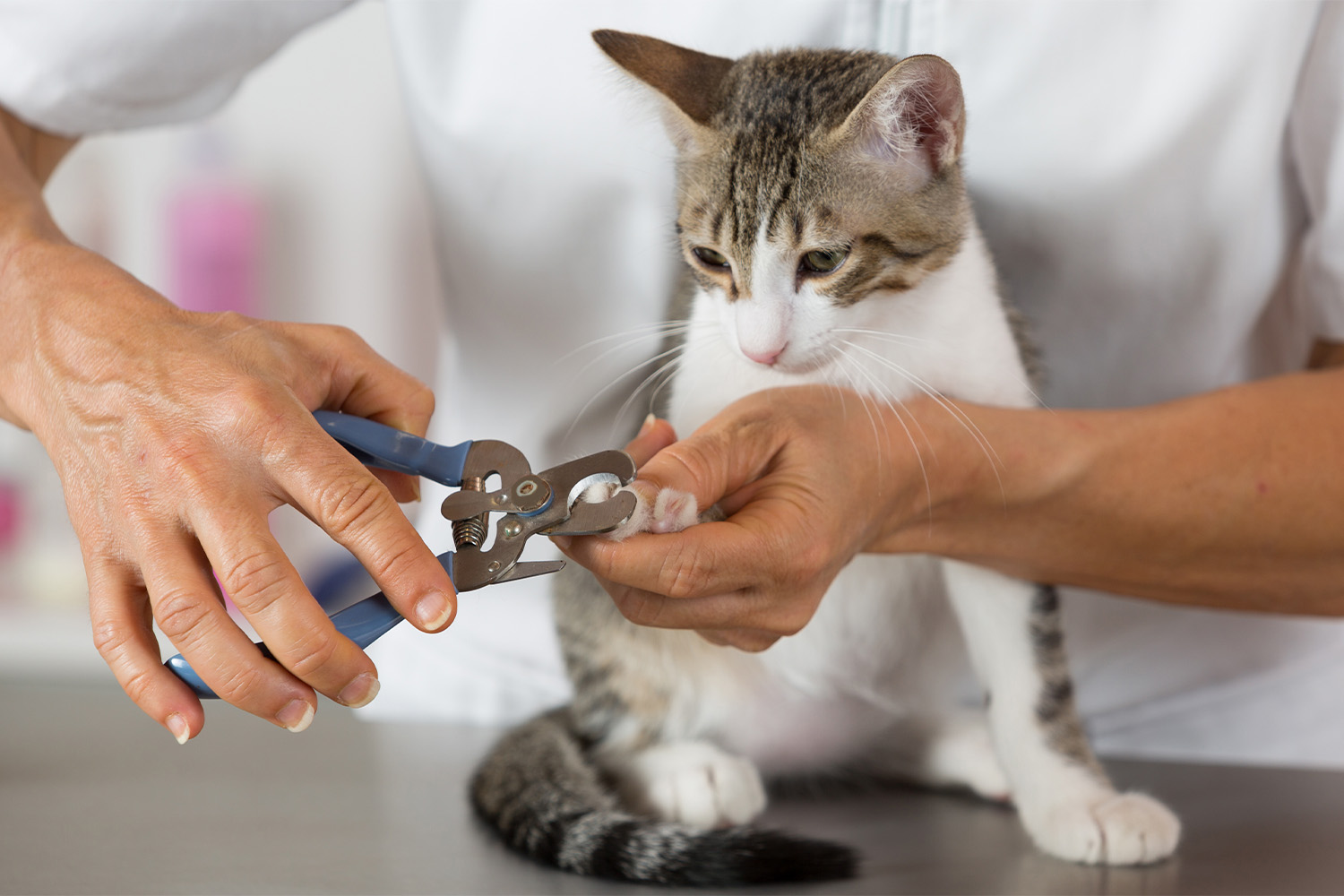A healthy cat is a happy cat — and while cats tend to be great at grooming themselves, even the most independent felines need a little extra care every once in a while! Whether your kitty needs a bath, a haircut, or a nail trimming, we’re here to provide all the guidance you need.
Keep reading for everything you need to know about grooming your cat.
Do I Need To Be My Cat’s Groomer?
First, let’s start with the basics: is cat grooming even necessary in the first place? After all, cats are notoriously fastidious about keeping clean. You’ve likely observed your kitty spending hours grooming, and/or licking their fur. Their natural aversion to baths of any sort might have you questioning whether the hassle of forcing them into the tub is really worth the aggravation and fuss.
It’s true that your kitty can, for the most part, take care of themself. Generally, a cat’s teeth and tongue are well-suited to handle the hairballs and grime of everyday wear and tear.
Still, every once in a while, cats might need extra help. If your cat has long hair that tends to get matted, is getting older and can no longer keep up with their own grooming needs, or has gotten into a literal sticky situation, this article is for you.
Note that if your cat proves to be rather tricky to bathe, you might want to head to a professional pet groomer. Your local veterinarian or pet salon (including mobile pet groomers) are experts.
How Do I Bathe My Cat?
We’ll jump right in with possibly the trickiest part of grooming your cat: bath time. Cats are notorious for despising water. Even the most relaxing and luxurious home bath routine can be fraught with the peril of getting clawed. (Despite this reputation, some very playful cat breeds, like the Bengal, do like water and might have tried to hop in the shower with you before!)
But maybe your cat got skunked or spent a bit too much time skulking through a trash heap, and you have no other option. We’ll walk you through a step-by-step guide to make the grooming process as painless as possible.
Consider Trimming Your Cat’s Claws
Step number one for bathing a water-averse feline: invest in some self-protection. Have you ever noticed your cat digging their claws into a piece of furniture or a scratching post? This is often a form of self-trimming, ensuring those claws are a sharp and healthy length. (However, this behavior can also signify boredom.)
Usually, you can get away with trimming your cat’s claws once a month. If you’re bathing your cat, though — an activity most cats aggressively dislike — you might want to trim those bad boys to protect yourself from getting sliced.
To trim your cat’s claws, you’ll first want to gather your supplies. You’ll need a pair of cat claw trimmers (scissors or clippers work fine), a towel or blanket to wrap your cat in, and some treats to reward your kitty for being a good sport.
Next, wrap your cat in the towel or blanket, making sure to leave their paws exposed. This will help keep them still and prevent them from scratching you. Then pick up your cat and locate their claws.
Be sure to identify a pink area at the base of each claw, called the “quick.” This area contains the blood vessels and nerves that keep the claw avoid, so it’s crucial to avoid cutting it.
Using your claw trimmers, carefully snip off the sharp tip of each claw, repeating this process several times if necessary to get all of the nails trimmed. Finally, reward your kitty with lots of praise (and maybe some treats) to help reinforce the idea that claw trimming isn’t ALL that bad.
Bath Time: An Essential Part of Pet Grooming
Bathing a cat may not be the most fun activity for either you or your feline friend. Still, it’s an integral part of being a responsible pet parent and is definitely worth the trouble if your pet has gotten itself into a sticky situation.
To give your cat a bath, you’ll need a cat-safe shampoo, a towel, a washcloth, and a cup for rinsing. Fill your sink or bathtub with a few inches of warm water, making sure the water isn’t too hot or too cold.
Then gently place your cat in the water and wet them down with the washcloth. Avoid getting soap on their face, especially in your cat’s ears or eyes. Take care to rinse them thoroughly to avoid leaving any soap residue on their fur.
Next, apply a small amount of cat-safe shampoo to your cat’s fur, and lather it in using your washcloth. Work the shampoo into their fur, taking care to avoid getting it in their eyes or ears.
Finally, rinse your cat thoroughly with warm water, and use the towel to gently dry them off. Reward your kitty with treats and lots of praise to reinforce good behavior next bath time (although chances are, they’ll streak away as soon as possible to sulk for a few hours under the nearest bed).
Do not use a hairdryer on your cat, as the noise is too loud for them to handle. Make sure they are left in a warm room to dry off fully, as their body temperature can drop quickly when wet.
Bathing a cat may not be the most enjoyable experience, but it’s an important part of keeping them healthy and happy and is a key part of regular grooming.
How Do I Brush My Cat?
Like we talked about earlier, even the most fastidious cat can use a grooming session every once in a while. Not only does regular brushing remove loose hair and prevent shedding, but it also helps to distribute natural oils throughout the fur and prevent tangles and mats.
To brush your cat, you’ll need a cat brush or comb with rough bristles and a quiet and comfortable spot to work. Not every cat enjoys the de-matting process; brushing somewhere quiet and relaxing might help make your job a little easier. A bed or couch works well. Additionally, you may want to wrap your cat in a towel or blanket to make them feel more secure.
Start by gently petting your cat and getting them desensitized to the cat brush. Slowly work your way up to their head, avoiding their ears and face, and brush in the direction of their fur growth.
Once you’ve finished brushing the top of your cat’s body, move on to their legs and paws. Gently brush out each leg and paw, avoiding their claws. Finally, brush your cat’s tail and backside, again brushing in the direction of their fur growth. (Brushing against the fur growth can exacerbate the buildup of tangles and mats rather than make them better.)
How Often Do I Need to Brush My Cat?
Some kitties might enjoy the grooming process, and you’ll have no difficulty corralling them for their regular brushing. With others, it might be more difficult and have you wondering how long you can go in between grooming sessions.
The answer depends on a few factors, including your cat’s breed, age, and health. In general, most cats benefit from being brushed at least once a week. This can help prevent tangles and mats. Plus, it can remove loose hair before it has a chance to shed and end up on your furniture or clothing.
If your cat has long, thick fur — in other words, if they are a long-haired cat, such as a Persian or Maine Coon — they may benefit from being brushed more often. This is especially true for older cats or cats with health conditions that make self-grooming difficult. In these cases, brushing your cat two to three times a week can help keep their coat healthy and prevent tangles and mats.
On the other hand, if your cat has short, smooth fur — a shorthaired cat, such as a British Shorthair or Russian Blue — they may not need to be brushed as often. In general, once a week should be sufficient, but you can adjust the frequency based on your cat’s individual needs.
Cat Ear Care: First-Time Tips
Ear cleaning can be another key aspect of pet care (although not every kitty will need your help with this step). You don’t need special equipment to clean your cat’s ears — just some ear-cleaning solution and a few cotton balls or pads. Never use Q-tips.
Start by gently lifting your cat’s earflap and using the cotton pad or ball to wipe away any dirt or debris you see in the ear. Be careful not to insert the cotton too far into the ear, or use cotton swabs or other pointed objects to clean your cat’s ears, as this can cause injury.
Once you’ve wiped away the visible dirt, put a few drops of ear-cleaning solution into your cat’s ear and massage the base of the ear gently to help the solution work its way into the ear canal.
Use a fresh cotton pad or ball to gently wipe away any excess solution and dirt that has been loosened. Repeat the process on the other ear. And voila! You’ve taken care of your kitty.
Become a (Quasi) Pro Cat Groomer (at Home)
Although most cats are great at grooming themselves, every once in a while, they’ll need extra assistance, whether that be ear cleaning, brushing, or getting a bath.
If you have questions about grooming your feline friend or any other pet-related matter, reach out to the Certified Pet Lifestyle Coaches™ at AskVet. Whether you have a question about a dog, cat, fish, lizard, or more, when you schedule a virtual session with CPLCs™, you have an expert to talk to. From behavioral to nutrition and everything in between, AskVet here is to help.
Sources:







